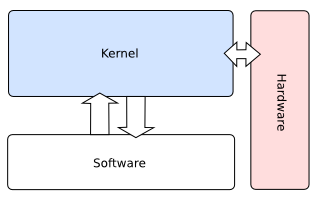Monolithic Kernel
| Kernel Designs |
|---|
| Models |
| Other Concepts |
Design
A monolithic kernel includes all (or at least, most) of its services in the kernel proper.
This reduces the amount of context switches and messaging involved, making the concept faster than a Microkernel. On the downside, the amount of code running in kernel space makes the kernel more prone to fatal bugs.
The word "monolithic" by itself means a single piece (mono) that is of or like stone (lithic), however when applied to kernels the exact meaning is more general. Most people[who?] consider that a kernel where device drivers and services run as part of the kernel is a monolithic kernel, regardless of whether parts are dynamically loaded "kernel modules" or if everything is a true single unchangeable binary. For this reason, a distinction can be drawn between "monolithic" and "pure monolithic".
Modern versions of Linux are a well-known example of a monolithic kernel - while drivers are shipped as dynamically loaded "kernel modules" they are still loaded into and running in kernel space. Monolithic kernels are common for the 80x86/PC architecture.
Examples of "pure monolithic" kernels are rare for the 80x86/PC architecture (but more common in embedded systems). This is because of the wide variety of devices, hardware and CPU features that may be present within a modern PC - a pure monolithic kernel would need to be far too large or compiled specifically for the computer before use.
In general most OS's aren't "pure monolithic" or "pure micro-kernel", but fall somewhere between these extremes in order to make use of the advantages of both methods.
Examples
- Linux
- MSDOS, including Windows 9x (95, 98, Me)
- Mac OS <= 8.6
- Most BSDs
- Xv6
